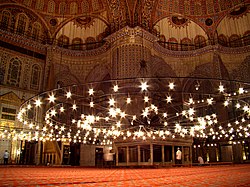The Galata Tower (Galata Kulesi in Turkish) — called Christea Turris (the Tower of Christ in Latin) by the Genoese — is a medieval stone tower in the Galata district of Istanbul, Turkey, just to the north of the Golden Horn. One of the city's most striking landmarks, it is a high, cone-capped cylinder that dominates the skyline and affords a panoramic vista of Old Istanbul and its environs
The tower was built as Christea Turris in 1348 during an expansion of the Genoese colony in Constantinople. It was the apex of the fortifications surrounding the Genoese citadel of Galata. The current tower should not be confused with the old Tower of Galata, an original Byzantine tower, named Megalos Pyrgos, which controlled the northern end of the massive sea chain that closed the entrance to the Golden Horn. That tower was on a different site and was largely destroyed during the Fourth Crusade in 1204.
The upper section of the tower with the conical cap was slightly modified in several restorations during the Ottoman period when it was used as an observation tower for spotting fires.
According to the Seyahatname of Ottoman historian and traveller Evliya Çelebi, in circa 1630-1632, Hezarfen Ahmet Çelebi flew as an early aviator using artificial wings for gliding from this tower over the Bosporus to the slopes of Üsküdar on the Anatolian side, nearly six kilometres away.[1] Evliyâ Çelebi also tells of Hezarfen's brother, Lagari Hasan Çelebi, performing the first flight with a rocket in a conical cage filled with gunpowder in 1633.
Starting from 1717 the Ottomans began to use the tower for spotting fires in the city. In 1794, during the reign of Sultan Selim III, the roof of the tower made of lead and wood and the stairs were severely damaged by a fire. Another fire damaged the building in 1831, upon which a new restoration work took place. In 1875, during a storm, the conic roof on the top of the building was destroyed. The tower remained without this conic roof for the rest of the Ottoman period.
Many years later, in 1965-1967, during the Turkish Republic, the original conical cap was restored. During this final restoration in the 1960s, the wooden interior of the tower was replaced by a concrete structure and it was commercialized and opened to the public.
The upper section of the tower with the conical cap was slightly modified in several restorations during the Ottoman period when it was used as an observation tower for spotting fires.
According to the Seyahatname of Ottoman historian and traveller Evliya Çelebi, in circa 1630-1632, Hezarfen Ahmet Çelebi flew as an early aviator using artificial wings for gliding from this tower over the Bosporus to the slopes of Üsküdar on the Anatolian side, nearly six kilometres away.[1] Evliyâ Çelebi also tells of Hezarfen's brother, Lagari Hasan Çelebi, performing the first flight with a rocket in a conical cage filled with gunpowder in 1633.
Starting from 1717 the Ottomans began to use the tower for spotting fires in the city. In 1794, during the reign of Sultan Selim III, the roof of the tower made of lead and wood and the stairs were severely damaged by a fire. Another fire damaged the building in 1831, upon which a new restoration work took place. In 1875, during a storm, the conic roof on the top of the building was destroyed. The tower remained without this conic roof for the rest of the Ottoman period.
Many years later, in 1965-1967, during the Turkish Republic, the original conical cap was restored. During this final restoration in the 1960s, the wooden interior of the tower was replaced by a concrete structure and it was commercialized and opened to the public.







